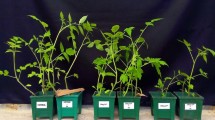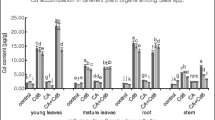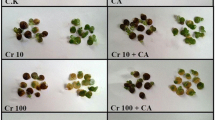Abstract
Chromium (Cr) toxicity is widespread in crops grown on Cr-contaminated soils and has become a serious environmental issue which requires affordable strategies for the remediation of such soils. This study was performed to assess the performance of citric acid (CA) through growing Brassica napus in the phytoextraction of Cr from contaminated soil. Different Cr (0, 100, and 500 μM) and citric acid (0, 2.5, and 5.0 mM) treatments were applied alone and in combinations to 4-week-old seedlings of B. napus plants in soil under wire house condition. Plants were harvested after 12 weeks of sowing, and the data was recorded regarding growth characteristics, biomass, photosynthetic pigments, malondialdehyde (MDA), electrolytic leakage (EL), antioxidant enzymes, and Cr uptake and accumulation. The results showed that the plant growth, biomass, chlorophyll contents, and carotenoid as well as soluble protein concentrations significantly decreased under Cr stress alone while these adverse effects were alleviated by application of CA. Cr concentration in roots, stem, and leaves of CA-supplied plant was significantly reduced while total uptake of Cr increased in all plant parts with CA application. Furthermore, in comparison with Cr treatments alone, CA supply reduced the MDA and EL values in both shoots and roots. Moreover, the activity of superoxide dismutase (SOD), guaiacol peroxidase (POD), catalase (CAT), and ascorbate peroxidase (APX) in shoots and roots markedly increased by 100 μM Cr exposure, while decreased at 500 μM Cr stress. CA application enhanced the activities of antioxidant enzymes compared to the same Cr treatment alone. Thus, the data indicate that exogenous CA application can increase Cr uptake and can minimize Cr stress in plants and may be beneficial in accelerating the phytoextraction of Cr through hyper-accumulating plants such as B. napus.




Similar content being viewed by others
References
Aebi H (1984) Catalase in vitro. Methods Enzymol 105:121–126
Ali S, Cai S, Zeng F, Qiu B, Zhang G (2012) Effect of salinity and hexavalent chromium stresses on uptake and accumulation of mineral elements in barley genotypes differing in salt tolerance. J Plant Nutr 35:827–839
Ali S, Farooq MA, Jahangir MM, Abbas F, Bharwana SA, Zhang GP (2013a) Effect of chromium and nitrogen form on photosynthesis and anti-oxidative system in barley. Biol Plant 57:785–791
Ali B, Wang B, Ali S, Ghani MA, Hayat MT, Yang C, Xu L, Zhou WJ (2013b) 5-Aminolevulinic acid ameliorates the growth, photosynthetic gas exchange capacity, and ultrastructural changes under cadmium stress in Brassica napus L. J Plant Growth Regul 32:604–614
Anwaar SA, Ali S, Ali S, Ishaque W, Farid M, Farooq MA, Sharif M (2015) Silicon (Si) alleviates cotton (Gossypium hirsutum L.) from zinc (Zn) toxicity stress by limiting Zn uptake and oxidative damage. Environ Sci Pollut Res 22:3441–3450
Anwer S, Ashraf MY, Hussain M, Ashraf M, Jamil A (2012) Citric acid mediated phytoextraction of cadmium by maize (Zea mays L.). Pak J Bot 44:1831–1836
Araújo JCT, Nascimento CWA (2010) Phytoextraction of lead from soil from a battery recycling site: the use of citric acid and NTA. Water Air Soil Pollut 211:113–120
Bareen FE (2012) Chelate assisted phytoextraction using oilseed brassicas. Environ Pollut 21:289–311
Boonyapookana B, Parkpian P, Techapinyawat S, Delaune RD, Jugsujinda A (2005) Phytoaccumulation of lead by Sunflower (Helianthus annus), Tobacco (Nicotianatabacum), and Vetiver (Vetiveriazizanioides). J Environ Sci Health 40:117–137
Bradford MM (1976) A rapid and sensitive method for the quantification of microgram quantities of protein utilizing the principle of protein-dye binding. Anal Biochem 72:248–254
Chigbo C, Batty L (2013) Effect of EDTA and citric acid on phytoremediation of Cr-B [a] P-co-contaminated soil. Environ Sci Pollut Res 20:8955–8963
Das BC, Panda A, Sahoo PK, Jena S, Padhi P (2014) Effect of chromium (VI) on wheat seedlings and the role of chelating agents. Curr Sci 106:1387–1395
Dhindsa RS, Plumb-Dhindsa P, Thorne TA (1981) Leaf senescence correlated with increased levels of membrane permeability and lipid peroxidation and decreased levels of superoxide dismutase and catalase. J Exp Bot 32:93–101
Dionisio-Sese ML, Tobita S (1998) Antioxidant responses of rice seedlings to salinity stress. Plant Sci 135:1–9
Diwan H, Ahmad A, Iqbal M (2008) Genotypic variation in the phytoremediation potential of Indian mustard for chromium. Environ Manag 41:734–741
Ehsan S, Ali S, Noureen S, Farid M, Shakoor MB, Aslam A, Bharwana SA, Tauqeer HM (2013) Comparative assessment of different heavy metals in urban soil and vegetables irrigated with sewage/industrial waste water. Ecoterra 35:37–53
Ehsan S, Ali S, Noureen S, Mehmood K, Farid M, Ishaque W, Shakoor MB, Rizwan M (2014) Citric acid assisted phytoremediation of Cd by Brassica napus L. Ecotoxicol Environ Saf 106:164–172
Evangelou M, Ebel M, Schaeffer A (2007) Chelate assisted phytoextraction of heavy metals from soil. Effect, mechanism, toxicity and fate of chelating agents. Chemosphere 68:989–1003
Farooq MA, Ali S, Hameed A, Ishaque W, Mahmood K, Iqbal Z (2013) Alleviation of cadmium toxicity by silicon is related to elevated photosynthesis, antioxidant enzymes; suppressed cadmium uptake and oxidative stress in cotton. Ecotoxicol Environ Saf 96:242–249
Freitas EVS, Nascimento CWA, Silva Sousa A, Silva FB (2013) Citric acid-assisted phytoextraction of lead: a field experiment. Chemosphere 92:213–217
Gill RA, Zang L, Ali B, Farooq MA, Cui P, Yang S, Ali S, Zhou W (2015) Chromium-induced physio-chemical and ultrastructural changes in four cultivars of Brassica napus L. Chemosphere 120:154–164
Gunawardana B, Singhal N, Johnson A (2011) Effects of amendments on copper, cadmium, and lead phytoextraction by Lolium perenne from multiple-metal contaminated solution. Int J Phytorem 13:215–232
Habiba U, Ali S, Farid M, Shakoor MB, Rizwan M, Ibrahim M, Abbasi GH, Hayat T, Ali B (2015) EDTA enhanced plant growth, antioxidant defence system and phytoextraction of copper by Brassica napus L. Environ Sci Pollut Res 22:1534–1544
Haouari CC, Nasraoui AH, Bouthour D, Houda MD, Daieb CB, Mnai J, Gouia H (2012) Response of tomato (Solanum lycopersicon) to cadmium toxicity: growth, element uptake, chlorophyll content and photosynthesis rate. Afr J Plant Sci 6:1–7
Heath RL, Packer L (1968) Photoperoxidation in isolated chloroplasts. I. Kinetics and stoichiometry of fatty acid peroxidation. Arch Biochem Biophys 125:189–198
Kanwal U, Ali S, Shakoor MB, Farid M, Hussain S, Yasmeen T, Adrees M, Bharwana SA, Abbas F (2014) EDTA ameliorates phytoextraction of lead and plant growth by reducing morphological and biochemical injuries in Brassica napus L. under lead stress. Environ Sci Pollut Res 21:9899–9910
Katz SA, Salem H (1994) The biological and environmental chemistry of chromium. VCH Publishers, New York
Laaniste P, Joudu J, Eremeev V (2004) Oil content of spring oilseed rape seeds according to fertilization. Agron Res 2:83–86
Lesage E, Meers E, Vervaeke P, Lamsal S, Hopgood M, Tack FMG, Verloo MG (2005) Enhanced phytoextraction: II. Effect of EDTA and citric acid on heavy metal uptake by Helianthus annuus from a calcareous soil. Int J Phytorem 7:143–152
Lichtenthaler HK (1987) Chlorophyll and carotenoids: pigments of photosynthetic biomembranes. Methods Enzymol 148:331–382
Mahmood T, Ejaz-ul-Hasan MA, Hussain M (2012) Faisal canola: a new high yielding canola variety for general cultivation in Punjab. J Agric Res 50:321–328
Meers E, Lesage E, Lamsal S, Hopgood M, Vervaeke P, Tack FMG, Verloo MG (2005) Enhanced phytoextraction: I. Effect of EDTA and citric acid on heavy metal mobility in a calcareous soil. Int J Phytorem 7:129–142
Melo EEC, Guilherme LRG, Nascimento CWA, Penha HGV (2012) Availability and accumulation of arsenic in oilseeds grown in contaminated soils. Water Air Soil Pollut 223:233–240
Meng H, Hua S, Shamsi IH, Jilani G, Li Y, Jiang L (2009) Cd-induced stress on the seed germination and seedling growth of Brassica napus L. and its alleviation through exogenous plant growth regulators. Plant Growth Regul 58:47–59
Metzner H, Rau R, Senger H (1965) Untersuchungen zur synchronisierbarkeit einzelner pigmentmangel-mutanten von Chlorella. Planta 65:186–194
Mishra S, Srivastava S, Tripathi RD, Govindarajan R, Kuriakose SC, Prasad MNV (2006) Phytochelatin synthesis and response of antioxidants during cadmium stress in Bacopa monnieri L. Plant Physiol Biochem 44:25–37
Mittler R, Vanderauwera S, Gollery M, Breusegem FV (2004) Reactive oxygen gene network of plants. Trends Plant Sci 9:490–498
Muhammad D, Chen F, Zhao J, Zhang G, Wu F (2009) Comparison of EDTA- and citric acid-enhanced phytoextraction of heavy metals in artificially metal contaminated soil by Typha angustifolia. Int J Phytorem 11:558–574
Najeeb U, Xu L, Ali S, Jilani G, Gong HJ, Shen WQ, Zhou WJ (2009) Citric acid enhances the phytoextraction of manganese and plant growth by alleviating the ultrastructural damages in Juncus effuses L. J Hazard Mater 170:1156–1163
Najeeb U, Jilani G, Ali S, Sarwar M, Xu L, Zhou WJ (2011) Insight into cadmium induced physiological and ultra-structural disorders in Juncus effusus L. and its remediation through exogenous citric acid. J Hazard Mater 186:565–574
Nakano Y, Asada K (1981) Hydrogen peroxide scavenged by ascorbate specific peroxidase in spinach chloroplasts. Plant Cell Physiol 22:867–880
Park H, McGinn PJ, Morel FMM (2008) Expression of cadmium carbonic anhydrase of diatoms in seawater. Aquat Microb Ecol 51:183–193
Raziuddin F, Hassan G, Akmal M, Shah SS, Mohammad F, Shafi M, Bakht J, Zhou W (2011) Effects of cadmium and salinity on growth and photosynthesis parameters of Brassica species. Pak J Bot 43:333–340
Rodriguez E, Santos C, Azevedo R, Moutinho-Pereira J, Correia C, Dias MC (2012) Chromium (VI) induces toxicity at different photosynthetic levels in pea. Plant Physiol Biochem 53:94–100
Schiavon M, Pilon-Smits EA, Wirtz M, Hell R, Malagoli M (2008) Interactions between chromium and sulfur metabolism. J Environ Qual 37:1536–1545
Schiavon M, Galla G, Wirtz M, Pilon-Smits EA, Telatin V, Quaggiotti S, Malagoli M (2012) Transcriptome profiling of genes differentially modulated by sulfur and chromium identifies potential targets for phytoremediation and reveals a complex S–Cr interplay on sulfate transport regulation in B. juncea. J Hazard Mater 239:192–205
Sharma P, Pandey S (2014) Status of phytoremediation in world scenario. Int J Environ Bioremed Biodeg 2:178–191
Singh HP, Mahajan P, Kaur S, Batish DR, Kohli RK (2013) Chromium toxicity and tolerance in plants. Environ Chem Lett 11:229–254
Su DC, Wong JWC (2004) Selection of mustard oilseed rape (Brassica juncea l.) for phytoremediation of cadmium contaminated soil. Bull Environ Contam Toxicol 72:991–998
Szczygłowska M, Piekarska A, Konieczka P, Namiesnik J (2011) Use of brassica plants in the phytoremediation and biofumigation processes. Int J Mol Sci 12:7760–7771
Tsetimi GO, Okieimen FE (2011) Chelate-assisted phytoextraction of metals from chromated copper arsenate (CCA) contaminated soil. J Environ Chem Ecotoxicol 3:214–224
Vamerali T, Bandiera M, Mosca G (2010) Field crops for phytoremediation of metal-contaminated land. Environ Chem Lett 8:1–17
Yeh TY, Pan CT (2012) Effect of chelating agents on copper, zinc, and lead uptake by sunflower, Chinese cabbage, cattail, and reed for different organic contents of soils. J Environ Anal Toxicol 2:2161–0525
Zeng F, Zhou W, Qiu B, Ali S, Wu F, Zhang G (2011) Subcellular distribution and chemical forms of chromium in rice plants suffering from different levels of chromium toxicity. J Plant Nutr Soil Sci 174:249–256
Zhang J, Kirkham MB (1994) Drought-stress induced changes in activities of superoxide dismutase, catalase and peroxidases in wheat leaves. Plant Cell Physiol 35:785–791
Zhang XZ (1992) The measurement and mechanism of lipid peroxidation and SOD POD and CAT activities in biological system. In: Zhang XZ (ed) Research Methodology of Crop Physiology, Beijing Agriculture Press, pp 208–211
Acknowledgments
Authors thank the Higher Education Commission of Pakistan for the financial support. The results presented in this paper are a part of MPhil studies of Sehar Afshan.
Author information
Authors and Affiliations
Corresponding author
Additional information
Responsible editor: Elena Maestri
Rights and permissions
About this article
Cite this article
Afshan, S., Ali, S., Bharwana, S.A. et al. Citric acid enhances the phytoextraction of chromium, plant growth, and photosynthesis by alleviating the oxidative damages in Brassica napus L.. Environ Sci Pollut Res 22, 11679–11689 (2015). https://doi.org/10.1007/s11356-015-4396-8
Received:
Accepted:
Published:
Issue Date:
DOI: https://doi.org/10.1007/s11356-015-4396-8




